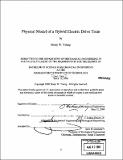Physical model of a hybrid electric drive train
Author(s)
Young, Brady W. (Brady William)
DownloadFull printable version (1.503Mb)
Other Contributors
Massachusetts Institute of Technology. Dept. of Mechanical Engineering.
Advisor
C. Forbes Dewey, Jr.
Terms of use
Metadata
Show full item recordAbstract
A motor and flywheel system was designed to simulate the dynamics of the electric drive train and inertial mass of a hybrid electric vehicle. The model will serve as a test bed for students in 2.672 to study the energy losses between the battery, motor, and kinetic energy of the car during acceleration and regenerative braking over a range of realistic driving profiles. The goal is to maintain fidelity to the dynamics of a road-worthy vehicle while making the model lab-safe and simple to operate. The model drive train will be designed on a one-to-one scale with the vehicle to be simulated. A motor and controller from an electric vehicle will be purchased to provide realistic electric drive for the system. The kinetic energy of the car will be simulated by a flywheel of equivalent mass. To keep the total energy in the system low enough to satisfy safety concerns, the system will be limited to simulating the motion of a light car moving up to ten miles per hour, representative of stop-and-go city traffic.
Description
Thesis (S.B.)--Massachusetts Institute of Technology, Dept. of Mechanical Engineering, 2006. Includes bibliographical references (p. 36).
Date issued
2006Department
Massachusetts Institute of Technology. Department of Mechanical EngineeringPublisher
Massachusetts Institute of Technology
Keywords
Mechanical Engineering.